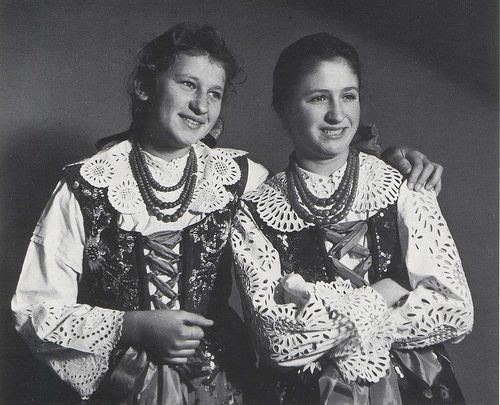 | ||
The Gorals (Polish: Górale; Slovak: Gorali; Cieszyn Silesian: Gorole; literally "highlanders") are an ethnographic (or ethnic) group primarily found in their traditional area of southern Poland, northern Slovakia, and in the region of Cieszyn Silesia in the Czech Republic (Silesian Gorals). There is also a significant Goral diaspora in the area of Bukovina in western Ukraine and in northern Romania, as well as in Chicago, the seat of the Polish Highlanders Alliance of North America.
Contents
- Population
- Language
- History
- Anthropology
- National identity
- Architecture
- Music
- Clasps
- Parzenica embroidery
- Corsets
- Other
- Religion
- References

Population
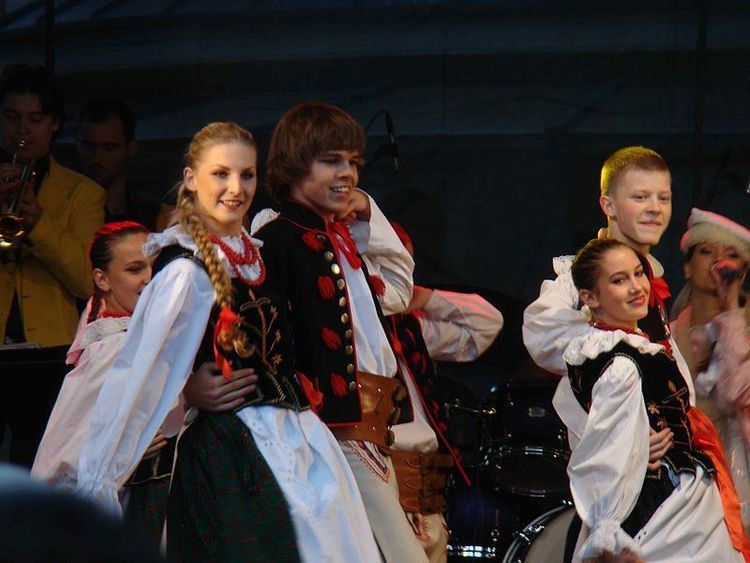
In Poland, the community inhabits the geographical region of Podhale of the Tatra Mountains and parts of the Beskids (Cieszyn Silesia, Silesian Beskids, Żywiec Beskids). In present-day Slovakia they live in 4 separate groups: in northern Spiš (34 villages subdivided in two groups), Orava and Kysuce (2 villages) and smaller groups in 7 other enclave villages in northern Slovakia.
The main settlements of Gorals include:
Language
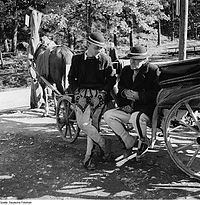
Gorals are part of a continuum of Carpathian Slavic highlander groups, including Hutsuls, Lemkos, and Boykos. The various dialects spoken by the Gorals descend from Proto-Slavic from the Eastern Lechitic, Old Polish area, superimposed by Slovak. In other words, the language, called the Podhale dialect (Polish: gwara podhalańska), is of Polish basis, but has been influenced by Slovak in recent centuries. In addition to Polish, the language contains some vocabulary of other origins, including Slovak, Eastern Romance, and words of uncertain origin that have cognates in other languages of the Carpathian region. Mazurzenie may occur.
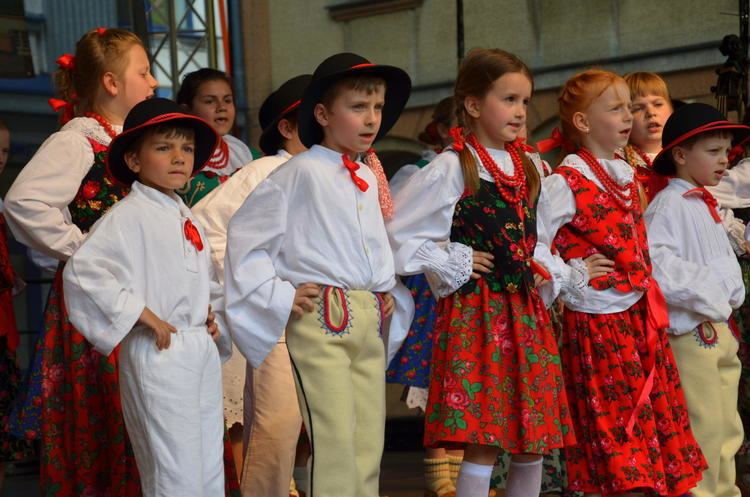
14th- and 15th-century palatal consonant pronunciation (called "Podhale archaisms") are preserved in the Podhale dialect. K. Dobroslowski asserted that the Podhale dialect had loan-words from Romanian and Albanian (1938), which indicates that the population is of Balkan Romance origin, also supported by similar belief system elements, music and material culture.
History
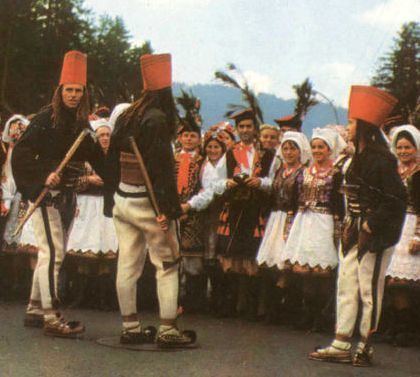
In the 16th and 17th centuries Gorals settled the upper Kysuca, Orava rivers, and part of northern Spiš. These territories were part of the northern Kingdom of Hungary. The mountainous regions were settled with pastoral Slavs with the "Vlach law". In 1803–19, Gorals migrated to Bukovina.
During World War II, Nazi Germany sought to Germanize the Gorals, along with the Estonians, Latvians and Lithuanians, and include them in the resettlement plans. According to Nazi racial laws, the White Russians, Gorals and Ukrainians were viewed of as "undesirable", and thus put under special statutes (labour and police law) in the occupied territories of Eastern Europe, although in milder degree to other non-German ethnic groups. The 27,000 strong Goral population were identified by Nazi racial experts as a separate ethnic group from the Poles. Termed Goralenvolk, they were deemed part of the "Greater Germanic Race" and worthy of separate treatment from the rest of the Poles.
Anthropology
The Gorals and other West Slavic peoples of the Carpathians show little northern, Germanic, influence, as opposed to other regions of Poland. Carleton S. Coon grouped the Gorals with the Hutsuls in the southeastern corner of Poland (now Ukraine). In the 19th century, Polish scholars viewed the Gorals as linguistically close to the Poles, but having close ties with Slovak folk culture. It was noted that Gorals' social and economic life resembled that of Vlach shepherd culture.
In a wider sense Gorals refers to an ethnographic (or even ethnic) group comprising certain highlanders in the northern Carpathians, more precisely these ethnic groups:
National identity
For most Gorals today, the decisive factor in their self-identification with a nationality is not ethnic but territorial. For example, those living in areas under a long tradition of belonging to the Polish state identify themselves as Polish, while those living in Slovakia have identified themselves as Slovaks, with notable exceptions to this rule on both sides of the border. While the origin of the Goral dialect is Polish, the language of Gorals in Slovakia and in the Czech Republic is gradually shifting and increasingly becoming more similar to the literary standard in their respective countries. Silesian Gorals of the Czech Republic identify themselves on the nationality level as Poles and are members of the Polish minority in Zaolzie, which is proved by their communal activity – annual Gorolski Święto festival held in Jablunkov (Jabłonków) is a showcase of a local Polish Goral traditions and is organized by the PZKO (Polish Cultural and Educational Union). This Goral festival preserves the traditions of the Polish nationality group in Zaolzie. It is the largest cultural and folklore festival in Zaolzie area gathering thousands of spectators each day of festivities.
However, in none of the towns and villages of the area the Poles form a majority and some local Gorals identify themselves on the nationality level as Czechs. In this respect the village of Hrčava (the second easternmost village in the Czech Republic), with vast majority of citizens declaring Czech nationality, can be mentioned. In this village the Poles form only a 2% minority. Local Gorals formed (as indigenous people) a majority in the past. They speak the regional dialect in everyday communication.
Historically, the issue of their ethnic identity has been controversial and resulted in claims and counterclaims by both Poland and Czechoslovakia. Gorals, like many other peasant communities in Central Europe, determined their own ethnic identities within the nation state system during the 19th and early 20th century. American anthropologists termed the Gorals "Black Russians", while noting that the western Gorals spoke Polish. Although nationalist propaganda was generated by both Poles and Slovaks, this process of the Gorals' identification with a nationality was still not complete when the border was finalized in 1924. A notable example were Ferdynand Machay, a priest born in Jabłonka, Orava, Piotr Borowy from Rabča, Orava and Wojciech Halczyn from Lendak, Spiš, who went to the Paris Peace Conference, 1919 and, during a personal audience, lobbied president Thomas Woodrow Wilson to sign these lands over to Poland. After the world wars, some of the Gorals who had opted for a different national identity to the state they found themselves in emigrated to their chosen side of the border. On the other hand, in the present day, some Gorals opt for the ethnic identity of the neighbouring state, rather than the one they live in.
Architecture
The Zakopane Style architecture, established at the end of the 19th century, is held as a Goral tradition. The architectural style draws on local architecture and Vernacular architecture of the Carpathians, and is widespread in the Podhale region.
Music
The Zakopower is a popular folk-pop musical group from Zakopane. The Trebunie-Tutki folk musical group from Zakopane blend traditional Goral music with reggae.
Clasps
For centuries clasps have been an important element of Polish highlanders’ traditional costumes. Originally used for fastening shirts, they fell out of use when buttons became popular, remaining only as ornaments. In the early 20th century they were already rare, used only by senior and young shepherds, who grazed their sheep on mountain pastures. In the 1920s and the 1930s they were considered collector's items and sought after by tourists. In Zakopane they were often worn as ornaments for the "cucha" (outerwear), sweaters or occasionally on leather bags.Today the clasps are a popular element of highlanders from the Podhale region, but the way they are worn differs from the original one: instead of fastening shirts they are usually attached to them or sewed on.
Parzenica (embroidery)
The parzenica embroidery dates back to the mid-19th century. Initially they were simple string loops, used for reinforcing cuts in front of cloth trousers. They had practical functions and protected the cloth from fraying. The modern look parzenica got from those tailors who began using red or navy blue string, simultaneously increasing the number of loops. Later the appliqué design was replaced with embroidery. Using woollen yarn allowed the parzenica to become more colourful and eventually it become a stand-alone trouser ornamentation, developed by talented tailors and embroiderers.
Corsets
In the second half of the 19th century it became fashionable in the Podhale region to adorn corsets with depictions of thistle and edelweiss. These motifs were the most popular in the early 20th century. When "Kraków style" came into fashion, highlanders of the Podhale region began ornamenting the corsets with shiny sequins and glass beads.
Other
In Cieszyn Silesia and northern Slovakia, the Shepherd's axe and elements of the folk costume are termed Vlach (Polish: wałaska, wałaszczaki, Slovak: valaška).
Highlanders Costumes in their collections have the following museums, e.g.: The National Museum of Ethnography in Warsaw, The Tatra Museum in Zakopane, the Ethnographic Museum of Kraków, the City Museum of Żywiec
Religion
Gorals are adherents of the Roman Catholic Church. The Sanctuary of Our Lady of Ludźmierz is of particular importance to the Gorals, being the oldest monument in the Podhale region. There are numerous cults connected to the church.
